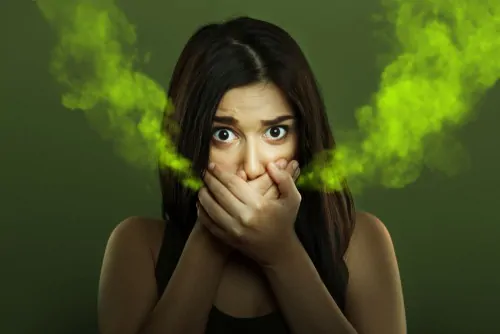
Having bad breath is not only embarrassing, but it could also be a sign of a bigger problem. While an odorous mouth is a completely normal side effect of eating something fragrant (garlic, anyone?), your dentist in Clinton Township wants you to know that chronic bad breath is something that warrants a dental visit sooner rather than later. These visits will help diagnose the underlying cause of your bad breath so that you and your dental team can find the best way to cure it. Let’s take a look at some of the most common causes of bad breath and ways you can make it go away.
Dry mouth is an annoying problem that many patients quickly dismiss. However, your dentist in Clinton Township will be the first to tell you that a dry mouth can lead to a whole host of problems, including bad breath. In a normal, moist mouth, saliva works hard to help neutralize and rinse away acid and bacteria which helps protect your teeth against decay. But when there’s not enough saliva, the mouth can feel dry, bacteria and acid quickly build up, both of which can directly cause decay as well as give off an unpleasant odor.
Dry mouth can be caused by medications, or it could also be hereditary. Treatment would vary depending on the cause of your dry mouth, but the easiest way to help is to make sure to drink plenty of water every day. Keeping your mouth hydrated is an important step in keeping it healthy. If you suspect medications are causing dry mouth and bad breath, talk with your doctor about other potential solutions.
When we don’t practice a good oral hygiene routine of brushing and flossing every day, leftover food particles are left behind in our mouths and wedged in between teeth. These food particles fuel mouth bacteria, and the combination of foodstuffs and bacteria can release a funky stench. Proper oral hygiene is important for everyone, but those who wear dentures may be at increased risk for bad breath if dentures aren’t cleaned regularly.
The best way to protect your breath from the dangers of bacteria is to remove it by brushing and flossing. Make sure to brush your teeth twice a day for at least two minutes and floss at least once a day to remove food particles and bacteria that have built up throughout the day. Of course, seeing your dentist in Clinton Township every six months will also help keep your teeth and breath fresh and clean.
Perhaps the most concerning cause of bad breath is gum disease. Gum disease, also known as periodontal disease, causes deep gum pockets where food and bacteria can easily hide, making them very difficult to remove through regular brushing and flossing. The result is not just bad breath – untreated gum disease has also been linked to increased risk of stroke, heart disease, respiratory complications, and tooth loss.
The best way to prevent gum disease and the bad breath that goes with it is again to follow a proper oral hygiene routine and see your dentist regularly. If gum disease is untreated it will get to a point where you will not be able to reverse it.
Nobody should have to live with the embarrassment of bad breath, and it shouldn’t be taken lightly. See your dentist as soon as possible if you notice chronic, recurring bad breath.
Having bad breath is not only embarrassing, but it could also be a sign of a bigger problem. While an odorous mouth is a completely normal side effect of eating something fragrant (garlic, anyone?), your dentist in Clinton Township wants you to know that chronic bad breath is something that… Read More…